#ai developers
Text
Simulations of Cybernetic Meadows - Recreating Life

Part 1 - History of Technology
The New Yorker recently put out a great article, covering the modern day conversations we're having about how "lifelike" AI systems are:
It's a great article, which covers a lot of modern discourse around the last 25 years around how we've attempted to make "lifelike" machines.
In an age of incredible speed and velocity in progress, we often forget how things have ended up this way. If you look, it turns out the quest for lifelike machines has been going on for a lot longer than people might suppose.
1st Century Antiquity - Age of Inquiry - The Mortal Hephaestus:
When people think of lifelike robots, they often jump to the robots of the 20th century. The past, however, is deep and full of secrets for those who know where to look.
youtube
Hero of Alexandria was a master craftsman, and mathematician, famous for one of the world's first steam engines, and Heron's formula for calculating the area of a triangle. He also created some of the first known humanoid automata.
This video is slightly misleading, as it shows a combination of his efforts, and that of another, but Hero himself was able to create moving automata that used weights as potential energy to drive wheeled devices around a room. The Herakleidon Museum does also have videos recreating his original mechanism.
The Greeks were, in particular, prolific in their creation of automata which mimicked life.

18th Century - Artisanal Age - Dreams of Automata
The writer is a mechanical automaton, created in 1770, by the aritst Pierre Jacquet-Droz. It is a marvel of early engineering, using a series of what are called "cams" to direct a machine in the shape of a child to write sentences.

It combines the mechanical aspects of writing, with the aesthetic appearance of a child, in order to create a work of art. It is also one of the first programmable machines, using a series of replacable letters to change what words are written.
youtube
But machines with lifelike qualities are not just limited to human motions. Master British automata makers John Joseph Merlin and John Cox created an astoundingly lifelike rendition of a swan in 1773, which preened its feathers, and caught fish from a pond.
youtube
Both of these devices were driven by the creation of advanced clockwork, and machining technologies. As with today's semiconductor revolution, clockwork started off the size of rooms until it was progressively miniaturized into the palm of your hand.
While the 18th century artisans and mechanists were able to create wondrous mechanical motions, they were not truly able to replicate the mechanics of "thinking". The writer is one of the few examples of programmatic "thinking", but cannot independently operate.
20th Century - The Cybernetic Age - Adaptation and Evolution:
The advent of thermodynamics, and the rise of electronics, led to new means by which to create "living machines".
In the 20th century, it also led to differing approaches to simulating life, such as cybernetics and expert systems.
Walter Grey's tortoise robots are a great example of the cybernetic attempts to create complex behaviours by using simple rules in the form of both a light and touch sensor.
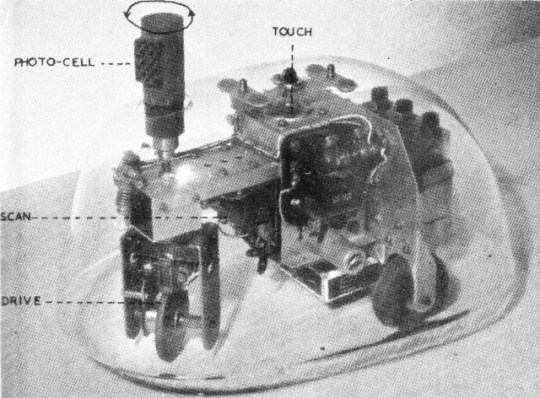
This robotic tortoise was able to exhibit very lifelike behaviours and reach goals without explicit instructed programming, such as with The Writer automaton.
This is a key "adaptation" and evolution from the concept of an automaton. Whereas automatons had simulated the mechanics of life though motion and muscle, robots such as the tortoise started to simulate the mechanics of thought through electronic wiring and circuitry.
The rise of the integrated circuit, and transistor, has been key to allowing modern automata/robots to reach advanced levels of ability unthinkable in pre-modern times.

Shakey represents another branch of 20th century robotics, the expert system, led by ideas similar to the 19th century automata, but updated exponentially.
By using several sensors, Shakey was able to navigate around rooms and create internal representations of the rooms it was in, in order to perform objectives.
21st Century - Age of Artificial Neural Networks - Memory and Thought:
Similar to the age of automata, we have entered another age of biomimicry, this time using Artificial Neural Networks. Instead of attempting to replicate the mechanics of actions, we are instead attempting to replicate the organic mechanics of thought.
One of the key ideas behind life is that it is self-sustaining - it operates all on its own. 18th/19th century automata weren't able to do this and 20th century automata/robotics did to a certain extent, but were often still viewed as machines with function.
youtube
Sony's AIBO represents a more "lifelike" kind of design - where the entire system is driven by "curiosity" rather than by specific instruction. While it posseses some subroutines, similar to its 20th century counterparts, it surpasses them in how it can also adaptively learn new behaviours to better suit its surroundings, both in practical settings (finding its way around) and social settings (recognising people, and interacting with them in a socially "successful" way).
The fields of reinforcement learning and artificial neural networks allow for complex behaviours to be simulated for the first time. Sony's AIBO is an excellent example of this in practice, with the robotic dog able to learn through positive reinforcement verbally, or via tactile methods, to promote certain behaviours.
It can even use computer vision capabilities to recognise specific users on sight, as well as allowing it to create its own internal model of the world around it.
Much like the 18th to 19th century automata, AIBO also attempts to replicate the actions of life itself, with its design, and actions, replicating that of a puppy or small dog. Unlike the automatons of old, however, the use of tactile, vision and sound sensors allow its form to play some function in its operation aside from aesthetics.
Cybernetic Meadows - The Future?
As we endow robotics systems with ever greater ability, how will we interact with them in the future, and how lifelike will they truly become?
Humanity has always, in some form or another, sought to replicate life itself through the medium of art and engineering. Only in time will we see the results.
#robotic#robot#robotics#automata#automaton#ai#ai research#ai development#ai developers#history of science#cybernetic#cybernetics#Youtube
3 notes
·
View notes
Text
🌐 Welcome to the forefront of artificial intelligence innovation AdeptAI
Progressive ML research and product lab, committed to shaping the future of general intelligence.

#ai#artificial intelligence#ai generated#ai tools#tools#digital tools#ai update#ai discussion#ai developers#ai business#ai community
2 notes
·
View notes
Text
2 notes
·
View notes
Text
Everything You Need to Know About Machine Learning
Ready to step into the world of possibilities with machine learning? Learn all about machine learning and its cutting-edge technology. From what do you need to learn before using it to where it is applicable and their types, join us as we reveal the secrets. Read along for everything you need to know about Machine Learning!

What is Machine Learning?
Machine Learning is a field of study within artificial intelligence (AI) that concentrates on creating algorithms and models which enable computers to learn from data and make predictions or decisions without being explicitly programmed. The process involves training a computer system using copious amounts of data to identify patterns, extract valuable information, and make precise predictions or decisions.
Fundamentally, machine Learning relies on statistical techniques and algorithms to analyze data and discover patterns or connections. These algorithms utilize mathematical models to process and interpret data. Revealing significant insights that can be utilized across various applications by different AI ML services.
What do you need to know for Machine Learning?
You can explore the exciting world of machine learning without being an expert mathematician or computer scientist. However, a basic understanding of statistics, programming, and data manipulation will benefit you. Machine learning involves exploring patterns in data, making predictions, and automating tasks.
It has the potential to revolutionize industries. Moreover, it can improve healthcare and enhance our daily lives. Whether you are a beginner or a seasoned professional embracing machine learning can unlock numerous opportunities and empower you to solve complex problems with intelligent algorithms.
Types of Machine Learning
Let’s learn all about machine learning and know about its types.
Supervised Learning
Supervised learning resembles having a wise mentor guiding you every step of the way. In this approach, a machine learning model is trained using labeled data wherein the desired outcome is already known.
The model gains knowledge from these provided examples and can accurately predict or classify new, unseen data. It serves as a highly effective tool for tasks such as detecting spam, analyzing sentiment, and recognizing images.
Unsupervised Learning
In the realm of unsupervised learning, machines are granted the autonomy to explore and unveil patterns independently. This methodology mainly operates with unlabeled data, where models strive to unearth concealed structures or relationships within the information.
It can be likened to solving a puzzle without prior knowledge of what the final image should depict. Unsupervised learning finds frequent application in diverse areas such as clustering, anomaly detection, and recommendation systems.
Reinforcement Learning
Reinforcement learning draws inspiration from the way humans learn through trial and error. In this approach, a machine learning model interacts with an environment and acquires knowledge to make decisions based on positive or negative feedback, referred to as rewards.
It's akin to teaching a dog new tricks by rewarding good behavior. Reinforcement learning finds extensive applications in areas such as robotics, game playing, and autonomous vehicles.
Machine Learning Process
Now that the different types of machine learning have been explained, we can delve into understanding the encompassing process involved.
To begin with, one must gather and prepare the appropriate data. High-quality data is the foundation of any triumph in a machine learning project.
Afterward, one should proceed by selecting an appropriate algorithm or model that aligns with their specific task and data type. It is worth noting that the market offers a myriad of algorithms, each possessing unique strengths and weaknesses.
Next, the machine goes through the training phase. The model learns from making adjustments to its internal parameters and labeled data. This helps in minimizing errors and improves its accuracy.
Evaluation of the machine’s performance is a significant step. It helps assess machines' ability to generalize new and unforeseen data. Different types of metrics are used for the assessment. It includes measuring accuracy, recall, precision, and other performance indicators.
The last step is to test the machine for real word scenario predictions and decision-making. This is where we get the result of our investment. It helps automate the process, make accurate forecasts, and offer valuable insights. Using the same way. RedBixbite offers solutions like DOCBrains, Orionzi, SmileeBrains, and E-Governance for industries like agriculture, manufacturing, banking and finance, healthcare, public sector and government, travel transportation and logistics, and retail and consumer goods.
Applications of Machine Learning
Do you want to know all about machine learning? Then you should know where it is applicable.
Natural Language Processing (NLP)- One area where machine learning significantly impacts is Natural Language Processing (NLP). It enables various applications like language translation, sentiment analysis, chatbots, and voice assistants. Using the prowess of machine learning, NLP systems can continuously learn and adapt to enhance their understanding of human language over time.
Computer Vision- Computer Vision presents an intriguing application of machine learning. It involves training computers to interpret and comprehend visual information, encompassing images and videos. By utilizing machine learning algorithms, computers gain the capability to identify objects, faces, and gestures, resulting in the development of applications like facial recognition, object detection, and autonomous vehicles.
Recommendation Systems- Recommendation systems have become an essential part of our everyday lives, with machine learning playing a crucial role in their development. These systems carefully analyze user preferences, behaviors, and patterns to offer personalized recommendations spanning various domains like movies, music, e-commerce products, and news articles.
Fraud Detection- Fraud detection poses a critical concern for businesses. In this realm, machine learning has emerged as a game-changer. By meticulously analyzing vast amounts of data and swiftly detecting anomalies, machine learning models can identify fraudulent activities in real-time.
Healthcare- Machine learning has also made great progress in the healthcare sector. It has helped doctors and healthcare professionals make precise and timely decisions by diagnosing diseases and predicting patient outcomes. Through the analysis of patient data, machine learning algorithms can detect patterns and anticipate possible health risks, ultimately resulting in early interventions and enhanced patient care.
In today's fast-paced technological landscape, the field of artificial intelligence (AI) has emerged as a groundbreaking force, revolutionizing various industries. As a specialized AI development company, our expertise lies in machine learning—a subset of AI that entails creating systems capable of learning and making predictions or decisions without explicit programming.
Machine learning's widespread applications across multiple domains have transformed businesses' operations and significantly enhanced overall efficiency.
#ai/ml#ai#artificial intelligence#machine learning#ai development#ai developers#data science#technology#data analytics#data scientist#data processing
3 notes
·
View notes
Text
The Role of an AI Development Company in Today's World
Artificial Intelligence (AI) has emerged as one of the most transformative technologies of our time, revolutionising industries, enhancing productivity, and reshaping the way we live and work. AI development companies play a crucial role in this transformation, acting as the bridge between cutting-edge AI research and practical, real-world applications. This blog explores the multifaceted role of AI development company in today's world, highlighting their contributions across various sectors, their approach to AI solutions, and the challenges they help overcome.
1. Driving Innovation Across Industries
AI development companies are at the forefront of innovation, leveraging AI technologies to create solutions that address complex challenges and unlock new opportunities. Their work spans multiple industries, each benefiting uniquely from AI advancements.
Healthcare
In healthcare, AI development companies are pioneering applications that improve patient outcomes, streamline administrative processes, and accelerate medical research. AI-driven diagnostics, for instance, can analyse medical images with high accuracy, aiding doctors in early detection of diseases such as cancer. Predictive analytics help in anticipating patient needs and managing hospital resources efficiently.
Finance
The financial sector benefits from AI through enhanced fraud detection, automated trading systems, and personalised banking services. AI algorithms can analyse vast amounts of transaction data to identify unusual patterns indicative of fraud. Robo-advisors provide tailored investment advice based on individual financial goals and risk profiles, democratizing access to sophisticated financial planning.
Retail
AI development companies are transforming retail by enabling personalised shopping experiences, optimising supply chains, and improving customer service. Recommendation engines, powered by AI, suggest products based on customer preferences and behaviour, increasing sales and customer satisfaction. AI-driven inventory management systems predict demand more accurately, reducing waste and ensuring product availability.
Manufacturing
In manufacturing, AI optimises production processes, enhances quality control, and predicts maintenance needs. AI-powered predictive maintenance systems analyse data from machinery to forecast potential failures, minimising downtime and maintenance costs. Quality control systems use computer vision to inspect products for defects in real-time, ensuring high standards and reducing waste.
2. Enhancing Business Processes
AI development companies play a vital role in enhancing business processes through automation and intelligent decision-making tools. These improvements lead to increased efficiency, cost savings, and better strategic planning.
Automation
Robotic Process Automation (RPA) and AI together automate repetitive and time-consuming tasks, freeing up human resources for more strategic activities. From data entry and invoice processing to customer support through chatbots, automation enhances productivity and reduces operational costs.
Data Analysis
AI development companies specialise in creating advanced data analytics tools that provide businesses with deeper insights. These tools can process and analyse large datasets quickly, uncovering trends and patterns that inform decision-making. Predictive analytics, for example, can forecast market trends, customer behaviour, and potential risks, enabling businesses to make proactive decisions.
Customer Relationship Management
AI-enhanced Customer Relationship Management (CRM) systems provide a more personalised and efficient customer experience. AI can analyse customer interactions and feedback to offer personalised recommendations, improve customer service, and predict customer needs. This leads to higher customer satisfaction and loyalty.
3. Fostering Technological Advancement
AI development companies are key players in advancing AI technology itself. They invest in research and development, contribute to academic knowledge, and collaborate with other tech entities to push the boundaries of what AI can achieve.
Research and Development
Continuous R&D efforts by AI development companies lead to innovations in algorithms, models, and AI applications. These companies often publish their findings, contributing to the broader AI research community and fostering further advancements.
Collaboration and Open Source
Many AI development companies engage in collaborative projects with academic institutions, other tech companies, and open-source communities. By sharing knowledge and resources, they accelerate technological progress and create more robust AI solutions.
Ethical AI
As AI becomes more pervasive, ethical considerations become crucial. AI development companies are responsible for developing AI systems that are fair, transparent, and unbiased. They work on creating frameworks and guidelines to ensure that AI is used responsibly and ethically.
4. Addressing Challenges and Mitigating Risks
The deployment of AI technologies comes with its own set of challenges and risks. AI development companies play a crucial role in addressing these challenges and mitigating associated risks.
Data Privacy and Security
AI systems require large amounts of data to function effectively. Ensuring the privacy and security of this data is paramount. AI development companies implement robust data protection measures and comply with relevant regulations to safeguard user data.
Bias and Fairness
AI algorithms can inadvertently perpetuate biases present in training data, leading to unfair outcomes. AI development companies strive to identify and eliminate bias in AI models, promoting fairness and equity in AI applications.
Reliability and Transparency
Ensuring the reliability and transparency of AI systems is critical, especially in high-stakes applications such as healthcare and finance. AI development companies work on creating explainable AI models that provide insights into how decisions are made, fostering trust and accountability.
5. Empowering Organisations and Individuals
AI development companies empower organisations and individuals by providing them with powerful tools and capabilities that enhance their productivity and decision-making processes.
Custom AI Solutions
These companies develop custom AI solutions tailored to the specific needs and goals of their clients. Whether it's a bespoke recommendation engine for an e-commerce platform or a predictive maintenance system for a manufacturing plant, custom solutions ensure that businesses get the maximum benefit from AI technologies.
Training and Support
AI development companies offer training and support services to help organisations integrate AI into their operations effectively. This includes educating staff on how to use AI tools, providing ongoing technical support, and ensuring the seamless operation of AI systems.
Democratizing AI
By making AI technologies more accessible and affordable, AI development companies help democratise AI. They develop user-friendly AI tools that do not require extensive technical expertise to use, enabling small businesses and individuals to leverage the power of AI.
Conclusion
In today's world, AI development companies are indispensable drivers of innovation and efficiency across various sectors. They bridge the gap between complex AI research and practical applications, providing businesses and individuals with the tools they need to thrive in an increasingly digital and data-driven landscape.
These companies enhance business processes through automation and intelligent decision-making tools, foster technological advancement through research and collaboration, and address the challenges and risks associated with AI development services. By empowering organisations with custom AI solutions and offering training and support, they make AI accessible and beneficial to a wider audience.
1 note
·
View note
Text
#Natural Language Processing#Machine Learning#software development#custom mobile app development services#Custom Application Development#AI in Custom Application Development#AI developers
0 notes
Text
The Future of Personal Banking: Generative AI in Finance Applications
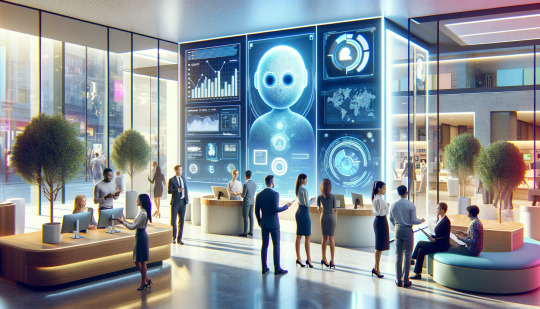
The banking sector is on the verge of a revolutionary reform with the introduction of generative AI that changes the view of personal banking. Envision a society where your bank not only you as a customer, but almost like a best friend—a friend who knows what you need, handles your expenses for you, and even shares tips on how to manage your finances and grow wealth. This is no futuristic story; this is almost our reality now due to fast growth of AI in Fintech industry.
Personalized Financial Guidance at Your Fingertips
Generative AI is not only about the replacement or automation of tasks but also about the formation of systems that can learn from data and produce humanized responses. This feature is utilized by AI Development company to redefine the customer interfaces in banking. Through chatbot development services which ensure 24/7 customer care to complex generative AI development services which impart personalized financial advice, the range of possible applications is broad and interesting.
For instance, think of a chatbot that doesn't simply answer your questions, but instead understands your financial trends, recommends you ways to save money, and alerts you about promising investments. Such kind of individual approach used to belong to those who specialized on personal financial advisory. Today, it is scalable to millions, resulting in the wide dissemination of good financial counseling.
Enhancing Security with Predictive AI
A noticeable benefit of the use of AI in personal banking is that it increases the level of security. Generative AI can recognize and detect fraudulent activities through recognition of transaction patterns that deviate from user's habitual financial behavior. This approach not only protects your assets but also builds up the trust for digital banking platforms.
Streamlining Operations and Reducing Costs
Banks are applying AI in two areas: customer experience improvement and the streamlining of operations and cost cutting. The automation of routine tasks enables banks to divert their resources to more important areas, for example product development and customer relationship management. This operational efficiency is precisely what you need in a highly competitive environment where the ability to cut costs and increase service at the same time can be a game-changer.
Future Prospects: AI as a Financial Advisor
The future of generative AI in the context of personal banking can only be predicted to be limitless. Think of AI systems that will negotiate better rates for you in a mortgage, invest in stocks with high returns or even manage your entire financial portfolio depending on live market data. These innovations could enhance the availability and lower expenses of financial advice, thus transforming personal banking into a more customer-oriented and technology-based industry.
The introduction of AI into the personal banking sphere necessitates that banking is not only efficient but also aligned with individual goals and dreams. It represents a win-win situation that suits both banks and customers who join forces to make modern financial experience more efficient and personal.
#ai in finance#ai development#ai developers#hire ai developers#business#hire chatbot developers#generative ai development services
0 notes
Text
AI Solutions Development Company: Transforming Businesses with Systimanx
#Systimanx, an #AIsolutionsdevelopmentcompany, empowers businesses with innovative AI-driven solutions, revolutionizing operations and enhancing productivity. Transform your business landscape with Systimanx's expertise in harnessing #AItechnologies for optimal efficiency and growth.
#ai development#ai developers#ai solutions#ai development company#ai development services#ai development solutions#technology
0 notes
Text

AI Solutions
Unlock the power of AI with our cutting-edge solutions! Whether it's optimizing workflows, enhancing customer experiences, or revolutionizing your business processes, our AI solutions are tailored to drive success. Let's shape the future together!
0 notes
Text
Unlocking Innovation: Exploring the Top AI Development Companies in the USA
In today's rapidly evolving technological landscape, artificial intelligence (AI) is a powerful catalyst for innovation across industries. From cutting-edge machine learning algorithms to advanced natural language processing solutions, AI has revolutionized businesses and enhanced human experiences. Join us as we embark on an exploration of the top AI development companies shaping the future of technology in the USA.
#ai developers#AI Development Services#Top AI Development Company#Top AI Development Companies in USA
1 note
·
View note
Text
Revolutionizing AI Development Services: Unlocking Innovation with JurySoft
In today's fast-paced digital landscape, harnessing the power of artificial intelligence (AI) is not just an option, but a necessity for businesses striving to stay ahead of the curve. From streamlining operations to enhancing customer experiences, the applications of AI are virtually limitless. However, for many organizations, navigating the complexities of AI development can be daunting. This is where JurySoft steps in, offering cutting-edge AI development services tailored to meet each client's unique needs.
At JurySoft, we understand that successful AI implementation requires more than just advanced technology; it requires a deep understanding of business objectives and industry-specific challenges. That's why our team of experts works closely with clients to develop custom AI solutions that drive tangible results. Whether it's predictive analytics, natural language processing, computer vision, or machine learning, we have the expertise to turn your AI ambitions into reality.
One of the key differentiators of JurySoft is our commitment to innovation. We don't just follow trends; we set them. Our dedicated research and development team is constantly pushing the boundaries of AI technology, exploring new algorithms, frameworks, and methodologies to ensure that our clients stay ahead of the competition. By leveraging the latest advancements in AI, we empower businesses to unlock new opportunities, optimize processes, and drive growth.
But our commitment to excellence doesn't end with the development phase. At JurySoft, we take pride in providing end-to-end support to our clients, from initial consultation to post-deployment maintenance. We understand that the success of an AI solution depends on its seamless integration into existing workflows and systems. That's why our team works tirelessly to ensure a smooth transition and ongoing support, allowing our clients to focus on what they do best – running their business.
What sets JurySoft apart is our passion for innovation, our commitment to excellence, and our relentless pursuit of customer satisfaction. Whether you're a startup looking to disrupt the market or an established enterprise seeking to stay ahead of the curve, JurySoft is your trusted partner for AI development services. Contact us today to learn how we can help unleash the full potential of AI for your business. Together, let's shape the future of technology.
0 notes
Text
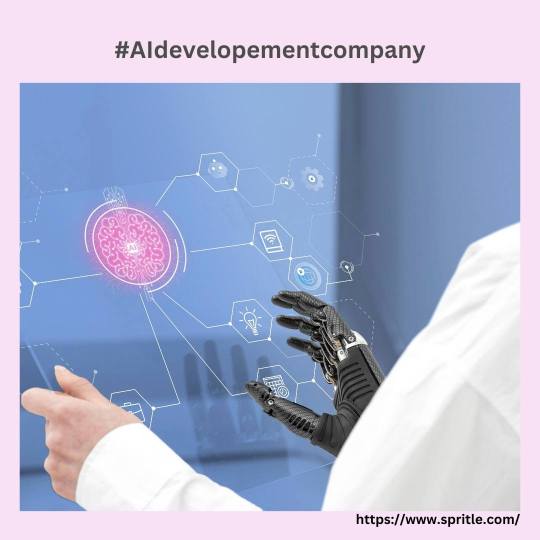
Transforming Visions into Reality: AI Development services by Spritle Software
Realize your vision with Spritle Software's AI development solutions. Our expert team transforms ideas into actionable strategies, leveraging the power of AI to drive tangible results and business success . AI Development company.
#ai development#ai development company#ai development services#ai#conversational ai#ai generated#ai developers#generative ai
0 notes
Photo
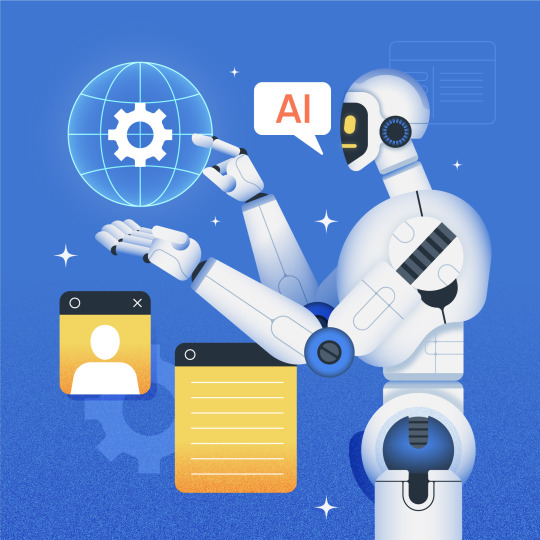
(via Leading the Way in AI Solutions Development)
0 notes
Text
artificial intelligence| ai development companies| ai in business| ai for business automation| ai development| artificial intelligence ai| ai technology|
ai companies| ai developers| ai intelligence| generative ai| ai software development| top ai companies| ai ops| ai software companies| companies that work on ai|
artificial intelligence service providers in india| artificial intelligence companies| customer service ai| ai model| leading ai companies| ai in customer support|
ai solutions for small business| ai for business book| basic knowledge for artificial intelligence| matching in artificial intelligence|
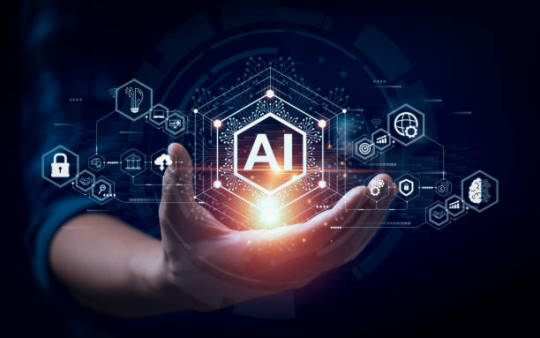
#artificial intelligence#ai development companies#ai in business#ai for business automation#ai development#artificial intelligence ai#ai technology#ai companies#ai developers#ai intelligence#generative ai#ai software development#top ai companies#ai ops#ai software companies#companies that work on ai#artificial intelligence service providers in india#artificial intelligence companies#customer service ai#ai model#leading ai companies#ai in customer support#ai solutions for small business#ai for business book#basic knowledge for artificial intelligence#matching in artificial intelligence
0 notes